Conditions were ripe in post-war America for a surge in population. Thousands of young men returned home from the war, eager to pursue dreams postponed during the war. The G.I. Bill enabled many to purchase a first home of their own, and a stronger economy encouraged them to begin to raise a family. The result was an unprecedented birthrate that began in 1946 and extended through 1964, reaching a peak of 4.3 million births in 1957.
Members of Minnesota's Greatest Generation who had grown up with hardship during the Great Depression and had dealt with shortages imposed by war wanted their children to have happy, carefree and abundant lives. Mothers turned to Dr. Benjamin Spock's bestselling baby care manual, The Common Sense Book of Baby and Child Care, for advice on raising their children. Families moved to the suburbs to provide a safer, more expansive environment for children to play. Stores catered to the desire of parents with more expendable income to provide a better life for their children with a range of furniture, clothing, toys and other childhood accoutrements.
The health and welfare of children was a high priority, particularly during the polio epidemic of the 1950s, which brought immunizations into the schools. The University of Minnesota placed a strong emphasis on child development studies, and offered educational programs for expectant parents.
Keen on providing the best possible education for baby boom children, taxpayers across the state supported the construction of larger, more modern schools and the hiring of more teachers to accommodate the growing numbers of students.
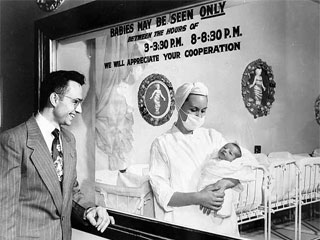

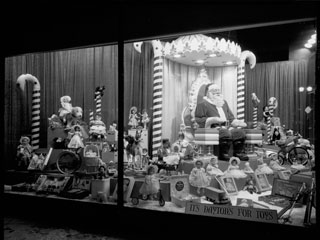

Oh, Baby!
Post-war prosperity combined with millions of young G.I.s returning to civilian life with a longing to marry and settle down prompted an unprecedented boom in the birthrate in the U.S. and around the world. During the period beginning in 1946 and ending in 1964, approximately 75 million babies were born in the United States, with 1,455,917 of them born in Minnesota. The Baby Boom peaked in the United States in 1957 when 4.3 milllion babies were born (123 out of every 1,000 women gave birth). Minnesota peaked two years later with 88,333 births.
Many members of Minnesota's Greatest Generation experienced their own "baby boom". Ed and Lee Sworsky, expecting their first child, were surprised with twins. Tom and Rose Marie Cousins, whose first child was born in 1953, went on to raise a brood of nine children.
Marian Maxson remembered her Richfield neighborhood to be teeming with kids, and recalled how all the neighbors pitched in to help watch the children while their mothers socialized. She and her friends enjoyed their stay-at-home moms status, and looked to each other for support and advice while raising their kids.
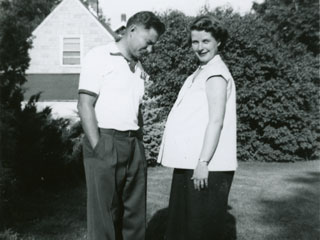
A Better Life For Our Children
Minnesota's Greatest Generation, with strong memories of growing up during the Great Depression, wanted to give their children advantages they didn't have.
To protect the health and well-being of their children, they sought expert advice on how to care for them, often reaching for a popular child care manual in addition to relying on tips from their parents and doctors. Richfield resident Carolyn Frederick credited the famous pediatrician, Dr. Benjamin Spock, for helping her to raise her children.
As families grew, they migrated to the suburbs in search of more room and a safer place for their children to grow up. Parents eagerly embraced local amenities that offered benefits to their families, such as parks and playgrounds. Stay-at-home moms socialized while their children played together, and helped to babysit for friends who held jobs. Emily Day of Richfield enjoyed her family's close proximity to Wood Lake Nature Center, family day trips into the country, and the support structure of good neighbors.
Post-war parents supported increases in tax levies to help pay for new, larger schools, and saved for homes and college educations. Shirley Boeser remembered the suburb of Bloomington opening thirteen schools in a single year to accommodate the large student population in that city.
Parents set aside time and money each year so that they could pack the kids into the station wagon and take a family vacation. They spent money on more toys and clothing than they could have imagined during their own childhoods, all in the hope of providing a better life for their children.

Citations:
- Statistical Abstract of the United States, 1946 to 1964. Washington, DC: U.S. Census Bureau.
- Minnesota State Demographic Center, St. Paul, Minnesota.
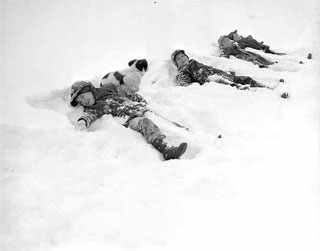 Photo: Children making angels in the snow, 1950.
Photo: Children making angels in the snow, 1950.- Benjamin Spock. Microsoft® Encarta® Online Encyclopedia 2008. 1997-2008 Microsoft Corporation. All Rights Reserved.
- Spock, Dr. Benjamin, The Common Sense Book of Baby and Child Care. New York: Pocket Books, an imprint of Simon & Schuster, 1946.
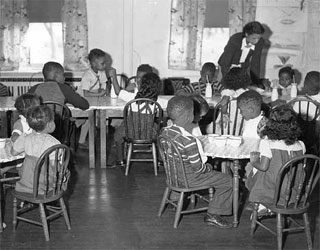 Photo: Lunch time at Phyllis Wheatley Nursery School, Minneapolis, 1950.
Photo: Lunch time at Phyllis Wheatley Nursery School, Minneapolis, 1950. Photo: Polio shots for children at Lincoln School, St. Cloud, 1953.
Photo: Polio shots for children at Lincoln School, St. Cloud, 1953.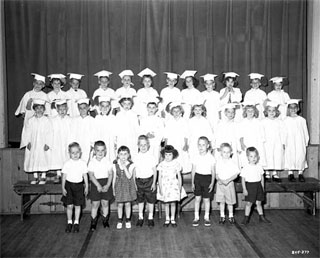 Photo: Graduates and other students at Margaret Barry Nursery School, 701 Fillmore Street, Minneapolis, 1957.
Photo: Graduates and other students at Margaret Barry Nursery School, 701 Fillmore Street, Minneapolis, 1957.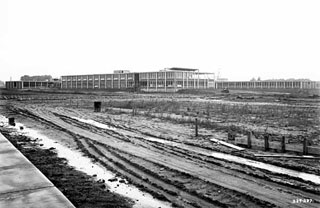 Photo: Construction of Fairview Junior High School, Roseville, 1956.
Photo: Construction of Fairview Junior High School, Roseville, 1956.
- Statistical Abstract of the United States, 1946 to 1964. Washington, DC: U.S. Census Bureau.
- Minnesota State Demographic Center, St. Paul, Minnesota.
- Sworsky, Edmond; Douglas Bekke, Interviewer, Edmond Sworsky Oral History Interview, 2006. Minnesota Historical Society Oral History Collection.
- Cousins, Daniel T. (Tom), Minneapolis Cousins' Family History through Christmas Letters, 2003.
- Maxson, Marian; Thomas Saylor, Interviewer, Marian Maxson Oral History Interview, Richfield Oral History Project, Minnesota Historical Society Oral History Collection, 2007.
 Photo: Marian Maxson and children with neighborhood friends.
Photo: Marian Maxson and children with neighborhood friends.
- Frederick, Carolyn; Linda Cameron, Interviewer, Carolyn Frederick Oral History Interview, Minnesota Historical Society, 2008.
- Benjamin Spock. Microsoft® Encarta® Online Encyclopedia 2008. 1997-2008 Microsoft Corporation. All Rights Reserved.
 Photo: Playground at Blandin Park beach, Grand Rapids, 1955.
Photo: Playground at Blandin Park beach, Grand Rapids, 1955.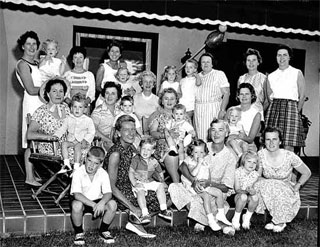 Photo: Mothers with their children, 1962.
Photo: Mothers with their children, 1962.- Day, Emily; Thomas Saylor, Interviewer, Emily Day Oral History Interview, Richfield Oral History Project, Minnesota Historical Society Oral History Collections, 2007.
- Boeser, Shirley; Thomas Saylor, Interviewer, Shirley Boeser Oral History Interview, Richfield Oral History Project, Minnesota Historical Society Oral History Collections, 2007.
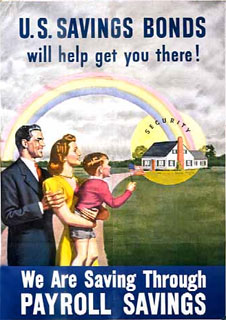 Photo: Poster: We Are Saving Through Payroll Savings, 1946.
Photo: Poster: We Are Saving Through Payroll Savings, 1946. Photo: Students urging voters to vote for school funding issue in February 25, 1964 election.
Photo: Students urging voters to vote for school funding issue in February 25, 1964 election.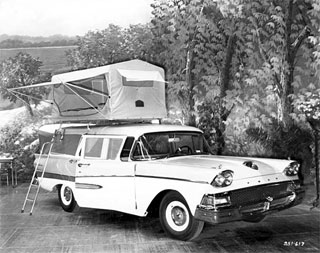 Photo: Tent mounted on top of a station wagon, Sportsmen's Show, 1958.
Photo: Tent mounted on top of a station wagon, Sportsmen's Show, 1958.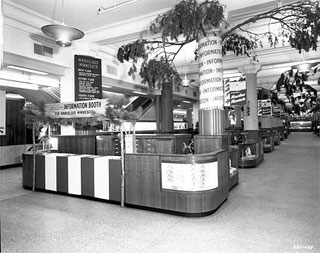 Photo: Minnesota vacation information booth at Dayton's, Minneapolis, 1955.
Photo: Minnesota vacation information booth at Dayton's, Minneapolis, 1955. Photo: Christmas window, Dayton's, Minneapolis, 1949.
Photo: Christmas window, Dayton's, Minneapolis, 1949. Photo: Window display of baby clothes and toys, The Baker Company, Minneapolis, 1949.
Photo: Window display of baby clothes and toys, The Baker Company, Minneapolis, 1949.


